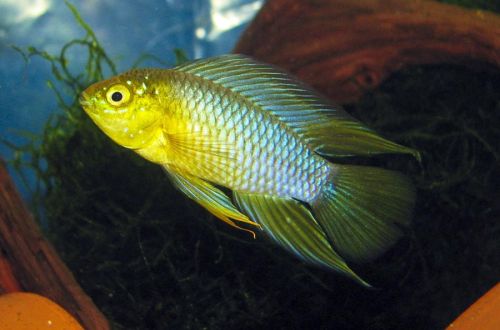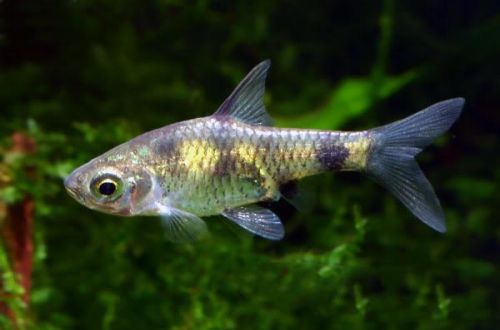
Gaboon Killy
The Gaboon Killy or Afiosemion fringed, scientific name Aphyosemion gabunense, belongs to the Nothobranchiidae family. Rainbow miniature fish, has a bright color that varies depending on the specific region of origin, thereby subdividing into three subspecies, although hybrid forms of these varieties are often on sale. The content is relatively simple, which cannot be said about breeding, experience is required here.
Habitat
It comes from a limited region of western Gabon (Africa) in the lower basin of the Ogowe River and its tributaries. Inhabits the swampy floodplain of the river and small adjoining streams. The area is characterized by a high density of aquatic vegetation.
Description
The size of adults does not exceed 5 cm. There is a pronounced sexual dimorphism, males have a bright color, females are faded, without a pronounced body pattern. The predominant color is reddish, wide spreading fins have characteristic specks on a yellow background and a wide red edging.
Food
In the home aquarium, they will accept all types of dry food, which contain protein components. It is recommended at least 2 times a week to serve live or frozen food from daphnia and bloodworms.
Maintenance and care
Decoration that recreates the natural biotope is the most acceptable option for decorating an aquarium. Fine sand substrate, silty; areas of dense vegetation are combined with free spaces with shelters in the form of snags, roots and branches of trees. Floating plants are recommended as a way to diffuse and shade the aquarium.
The set of equipment is standard and includes a heating, lighting, aeration and filtration system. When installing the filter, place it in such a way that the outgoing water streams break against some obstacle, thereby reducing the internal flow. Afiosemion fringed prefers calm waters with stagnant water.
Permissible water parameters have very wide parameters, ph is in the region of slightly acidic values, dGH is from soft to medium hardness. When filling the aquarium and then renewing part of the water, in most cases it is enough to stand tap water, provided that the hardness is not very high. For more information about pH and dGH parameters, as well as ways to change them, see the “Hydrochemical composition of water” section.
Maintenance of the aquarium is reduced to the weekly replacement of part of the water (10-15% of the volume) with fresh, regular cleaning of the soil from organic waste and glass from plaque.
Behavior and Compatibility
A peaceful and shy species, it is possible to keep in the general aquarium, but the choice of neighbors should be taken with great care. Only compatible with fish of similar or smaller size and temperament.
Breeding / breeding
Spawning is recommended to be carried out in a separate tank in order to protect the offspring from their own parents and other aquarium neighbors. As a spawning aquarium, a small capacity of about 10 liters is suitable. Of the equipment, a simple sponge airlift filter, a heater and a lamp for lighting are sufficient.
In the design, you can use several large plants as decoration. The use of a substrate is not recommended for ease of further maintenance. At the bottom, you can place a finely meshed mesh through which the eggs can pass. This structure is explained by the need to ensure the safety of eggs, since parents are prone to eating their own eggs.
A selected pair of adult fish is placed in a spawning aquarium. The stimulus for reproduction is the establishment of a water temperature in the range of 21–24 ° C at neutral pH values and the inclusion of live or frozen meat products in the daily diet. Be sure to clean the soil from food residues and organic waste (excrement) as often as possible, in a cramped space, water quickly becomes contaminated.
The female lays eggs in portions of 10–20 once a day for two weeks. Each portion of eggs should be carefully removed from the aquarium (this is why no substrate is used) and placed in a separate container, for example, a tray with high edges to a water depth of only 1-2 cm, with the addition of 1-3 drops of methylene blue, depending on the volume . It prevents the development of fungal infections. Important – the tray should be in a dark, warm place, the eggs are extremely sensitive to light.
The incubation period lasts from 18 to 22 days. Juveniles also appear not at a time, but in batches, newly appeared fry are placed in a spawning aquarium, where at that time their parents should no longer be. After two days, the first food can be fed, which consists of microscopic organisms such as brine shrimp nauplii and slipper ciliates. In the second week of life, live or frozen food from brine shrimp, daphnia, etc. is already used.
As well as during the spawning period, pay great attention to the purity of the water. In the absence of an effective filtration system, you should regularly clean the spawning aquarium at least once every few days and replace some of the water with fresh water.





